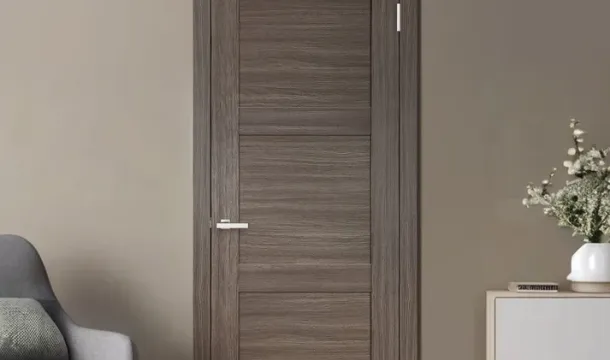How to Fix Common Interior Door Problems - Squeaks, Sticking, and Gaps
Popular Articles
If you're dealing with annoying noises or misalignment in your entryways, quick solutions are available. First, for those irritating sounds, applying a silicone-based lubricant to the hinges can significantly reduce noise. A few drops will suffice; ensure you wipe off any excess to prevent dust accumulation.
For doors that refuse to close smoothly, check for obstructions or misaligned frames. Sometimes, simply tightening screws on the hinge can rectify the sticking problem. If the door is warped, consider using shims to adjust its position within the frame.
Another frequent concern is unwanted spaces around the edges of the door. Weatherstripping can be an effective remedy here, providing insulation and preventing drafts. Measure carefully and apply it along the perimeter where gaps exist for a snug fit.
Addressing these common concerns not only enhances functionality but also improves overall aesthetics and comfort in your home.
Repairing Frequent Problems with Doors
Address gaps by adjusting the hinges or using a door shim to create a snug fit. Inspect the alignment and ensure the door is seated properly within the frame.
To eliminate annoying noises, apply lubricant to hinges. WD-40 or silicone spray works effectively; just avoid over-saturating to prevent mess.
- Remove the hinge pins for thorough cleaning if squeaks persist.
- Replace old hinges if they are rusted or damaged.
If a door sticks, check for swelling due to humidity. Sand down areas that rub against the frame, focusing on high-contact spots. A coat of paint or sealant can also help protect against moisture.
- Loosen screws on hinges slightly and reposition the door.
- Use a level to verify proper hanging; adjust as needed.
For any lingering issues, consider replacing hardware. New knobs or latches can resolve sticking and improve functionality significantly.
Eliminating Door Squeaks
Apply a lubricant such as silicone spray or graphite powder directly onto the hinges. This method provides immediate relief from annoying noise.
If lubrication doesn't resolve the problem, check for misalignment. Adjust the hinge screws to ensure that the door hangs properly and make contact with the frame evenly.
In cases where gaps between components cause friction, consider using shims to elevate or stabilize the door's position. This adjustment can significantly reduce unwanted sounds.
Regular maintenance is key; inspect hinges periodically for wear and tear. Replace any damaged hardware to maintain smooth operation.
A door that frequently squeaks may also indicate structural issues, so assess its alignment and levelness within the frame. Addressing these concerns can lead to a long-lasting fix.
Resolving Sticking Doors
To address a door that refuses to open or close smoothly, begin by inspecting the hinges. Often, accumulated dirt and rust can hinder movement. Clean the hinges thoroughly and apply a lubricant such as WD-40 or silicone spray to ease operation.
If the frame appears misaligned, check for any visible signs of wear or damage. Tighten screws on the strike plate and adjust it if necessary. A simple adjustment can create a better fit, eliminating friction points.
Another common source of trouble is swelling caused by humidity. If moisture has expanded the wood, consider sanding down specific areas where contact occurs. Focus on edges that rub against the frame to restore proper clearance.
Should gaps appear between the door and its frame after adjustments, use weatherstripping to seal these spaces effectively. This not only improves functionality but also enhances energy efficiency within your space.
Finally, ensure that all hardware is secure. Loose components can exacerbate problems; thus, a complete inspection of screws and fittings will contribute significantly to overall performance.
Addressing Gaps Between Frames
To eliminate spaces between the frame and the structure, begin by assessing the alignment of the door. If misaligned, adjust the hinges by tightening or loosening screws to achieve proper positioning.
If gaps persist, consider using weatherstripping as a straightforward remedy. This material can fill voids effectively, enhancing insulation and reducing drafts. Choose a type that suits your specific needs–adhesive-backed options are particularly user-friendly.
For larger openings, applying caulk is another viable solution. Use a high-quality caulk designed for indoor use to seal any noticeable cracks. Ensure the surface is clean and dry before application for optimal adhesion.
In cases where adjustments do not resolve the problem, shimming may be required. Insert wooden or plastic shims behind the hinges to elevate one side of the frame slightly, aligning it better with the door panel.
Regular maintenance checks can help identify these problems early on. Keep an eye on shifting structures due to temperature fluctuations or humidity changes that might exacerbate these concerns over time.
Implementing these strategies will significantly improve fit and function while prolonging the lifespan of your entryways.
Tightening Loose Hinges
To resolve the problem of a wobbly entry, examine the hinges closely. Use a screwdriver to tighten any loose screws in the hinge plates. If screws are stripped, replace them with longer ones for a secure fit.
For enhanced stability, apply a drop of machine oil to the hinge pin before reassembling. This reduces friction and may eliminate unwanted noise during operation.
If issues persist after tightening, consider removing the hinge entirely. Inspect for damage; if necessary, replace it to ensure proper alignment and function.
A well-secured hinge contributes significantly to overall performance, reducing gaps and minimizing noise while improving ease of use.
Replacing Damaged Hardware
To resolve recurring problems, consider replacing any compromised components. Inspect hinges, knobs, and latches for wear or damage. If they exhibit rust or unusual movement, it's time for a swap.
Choose high-quality hardware that fits your specific needs. Ensure that new hinges are the same size and type as the old ones to maintain functionality. For knobs and locks, select models compatible with existing holes.
Installation is straightforward: remove the old hardware using a screwdriver, align the new pieces accurately, and secure them firmly. This simple solution can significantly enhance performance and eliminate annoying sounds.
After installation, test each component to confirm smooth operation. Address any misalignment immediately to prevent further complications down the line.
Regular checks of hardware can preempt deterioration, ensuring seamless operation over time. A proactive approach will keep your space looking polished while avoiding potential frustrations from faulty elements.
Popular Articles

Soundproofing Interior Doors: Which Options Are Best for Your Home?

Choosing the Perfect Interior Doors for Your Canadian Home
